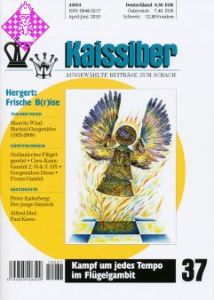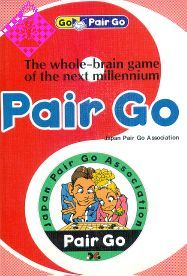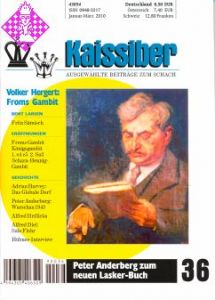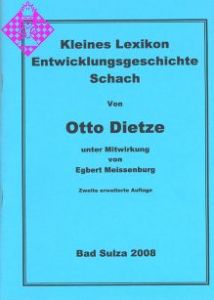Artikelnummer
LORUDZE
Autor
Zuke 'Em
The Colle-Zukertort Revolutionized
350 Seiten, kartoniert, Eigenverlag, 3. Auflage 2015, Erstauflage 2008
Final vergriffen
For decades, the chess world has run down the reputation of the Colle-Zukertort (a.k.a. the Rubinstein Attack) as an unassuming opening, claiming it did not exact the full measure of pain from Black in the quest to equalize.
If such is the case, why do strong players (as Black) avoid the Zukertort? Instead, they opt to play any of several pet defenses rather than deal with the constriction and onslaught from the main line.A WHOLE NEW SYSTEM OF JUSTICE: ZUKE 'EMIn Zuke 'Em: The Colle-Zukertort Revolutionized, Rudel explains the basics of the Zukertort and then provides plenty of new ideas to address these various pet defenses that cowardly opponents may choose. In this book you will also find:
Forward wind 8 years and in 2004 I received an e-mail from David Rudel suggesting a creative solution to the 3...g6 probthat had previously eluded me. I congratulated him for his vision and thought no more of it. However, David evidently did a great deal of thinking about the Colle and the result is the book you have in your hands. One of the things that imimpressed me about the book is how much thought and effort has obviously gone into it. Although it is possible to just bash your moves out in the Colle-Zukertort without much thought, a savvy opponent will make your life very difficult inif you pay no attention to move order. In this book David takes you on a journey avoiding the trapdoors set by sneaky opponents and into a middlegame where you have a fair idea of what you are trying to achieve. He doesn't shirk from using game statistics to tell you if a particular line doesn't score well and you can look forward to learning the role of each piece as the position evolves.
All in all if you are looking for an offbeat way to surprise your opponents and yet at the same time keep a solid foundafrom which to attack, then this just might be the perfect book for you.
Aaron Summerscale
London, April 2008
If such is the case, why do strong players (as Black) avoid the Zukertort? Instead, they opt to play any of several pet defenses rather than deal with the constriction and onslaught from the main line.A WHOLE NEW SYSTEM OF JUSTICE: ZUKE 'EMIn Zuke 'Em: The Colle-Zukertort Revolutionized, Rudel explains the basics of the Zukertort and then provides plenty of new ideas to address these various pet defenses that cowardly opponents may choose. In this book you will also find:
·Introductory chapters for those who would not know the Zukertort from a Lemon Torte
·Analysis in real English from the perspective of someone who has played the opening exclusively for over a decade
·A barrage of never-before-published answers and extensive commentary on common lines
·A training section to help you retain and test your understanding of the opening
Foreword
The Colle-Zukertort opening system is generally seen as a way for White to avoid having to learn lots of opening theory. Indeed it was this opinion that attracted me towards playing the opening on a regular basis. White, I thought, can bash out his first 8 or 9 moves and get the sort of position he is familiar with. Then it was a case of using my better experiin the line to out-maneuver my opponents. It took a while to iron out some of the wrinkles but eventually it turned into an opening I was happy to play against GM's with fairly good results. The culmination of this was when I decided to write a White repertoire book, A Killer Chess Opening Repertoire, based on the Colle-Zukertort and other slightly offbeat White systems in 1996. One of the drawbacks of writing a book like this is that your competitors can immediately see the systems that cause you the most trouble and start remorselessly using them against you. One particularly irksome move order was 1. d4 d5 2. Nf3 Nf6 3. e3 g6. And to be honest I never truly found a way I was completely happy with to overcome this problem. I eventually moved onto new opening pastures.Forward wind 8 years and in 2004 I received an e-mail from David Rudel suggesting a creative solution to the 3...g6 probthat had previously eluded me. I congratulated him for his vision and thought no more of it. However, David evidently did a great deal of thinking about the Colle and the result is the book you have in your hands. One of the things that imimpressed me about the book is how much thought and effort has obviously gone into it. Although it is possible to just bash your moves out in the Colle-Zukertort without much thought, a savvy opponent will make your life very difficult inif you pay no attention to move order. In this book David takes you on a journey avoiding the trapdoors set by sneaky opponents and into a middlegame where you have a fair idea of what you are trying to achieve. He doesn't shirk from using game statistics to tell you if a particular line doesn't score well and you can look forward to learning the role of each piece as the position evolves.
All in all if you are looking for an offbeat way to surprise your opponents and yet at the same time keep a solid foundafrom which to attack, then this just might be the perfect book for you.
Aaron Summerscale
London, April 2008
| EAN | 9781888710786 |
|---|---|
| Gewicht | 350 g |
| Hersteller | Eigenverlag |
| Breite | 15,2 cm |
| Höhe | 22,8 cm |
| Medium | Buch |
| Erscheinungsjahr | 2015 |
| Autor | David Rudel |
| Sprache | Englisch |
| Auflage | 3 |
| ISBN-13 | 9781888710786 |
| Jahr der Erstauflage | 2008 |
| Seiten | 350 |
| Einband | kartoniert |
| Name | Eigenverlag |
|---|
007 Foreword
009 01. Why?
023 02. Introduction: The Enigmatic Zukertort
047 03. The Cast
058 Zukertort Principles, Wisdom, and Guidelines
059 04. The Mainline
109 05. Classical Variation - A Thematic Treatment
133 06. Early Bishop Deviations
169 07. The Slav Defense
205 08. The Queen's Indian and Benoni Defenses
223 09. The Sneaky Grünfeld
235 10. The Queen's Gambit Reversed
269 11. Various Oddities
301 12. Extra Analysis
331 13. Training
339 14. New Ideas Index
345 15. Variation Index
347 16. Bibliography
349 About the Author
350 Colophon
009 01. Why?
023 02. Introduction: The Enigmatic Zukertort
047 03. The Cast
058 Zukertort Principles, Wisdom, and Guidelines
059 04. The Mainline
109 05. Classical Variation - A Thematic Treatment
133 06. Early Bishop Deviations
169 07. The Slav Defense
205 08. The Queen's Indian and Benoni Defenses
223 09. The Sneaky Grünfeld
235 10. The Queen's Gambit Reversed
269 11. Various Oddities
301 12. Extra Analysis
331 13. Training
339 14. New Ideas Index
345 15. Variation Index
347 16. Bibliography
349 About the Author
350 Colophon
Dieses Buch stammt aus den USA, geschrieben von einem US-Ameri- das bedeutet u.a., dass sich der europäische Leser an einige Bein Form, Stil und Auferst gewöhnen muss, so leitet sich etwa der Titel „Zuke EM" in einem Wortspiel von dem Video„Duke Nukem" ab, von dem auch das Titelbild mit seinem im Gefolge (kriegsmäßiger) Explosiound Gewehrfeuer auf einem Schachbrett landenden Fallschirmjäentlehnt sein dürfte. Zum zweiist der Autor David Rudel ein bekannter Mathematiker und Entvon Lehr-Software mit den Interessen Theologie und Colle-Zukertort-Eröffnung, welch letztere er seit mehr als zehn Jahren erfolgreich praktiziert.
So nimmt es drittens auch nicht wunder, dass sein Buch in der Prädes Stoffes einen etwas anals den gewohnten Aufbau vergleichbarer Eröffnungswerke aufweist, angereichert mit vielen verbalen Erklärungen und von ihm empfohlenen entdeckten NeuerunZur Auflockerung lässt er zuan mehreren Stellen ein fiktives Alter Ego Fragen stellen, die er soim weiteren Text beantwortet Hier nun kurzgefasst der Inhalt:
1) „Warum" sollte man die Colle-Zukertort-Eröffnung spielen? Weil der Weiße einen vorgezeichneten zum Königsangriff erhält, basierend auf der Tabien-artigen Aufstellung d2-d4, e2-e3, b2-b3, Sg1-f3, Sb1-d2, Lf1-d3, Lc1-b2 und 0-0 (S. 7-19).
2) "Einführung zum rätselhaften Zukertort": Nach dem Eindruck des Verfassers beanspruchen die Seitenfast mehr Aufmerksamkeit als die Hauptvarianten (S. 20-34).
3) „Die Gestalt": Der Autor erklärt schematisch Aufstellung und Funktialler 32 Schachsteine bei der Colle-Zukertort-Eröffnung, und ergänzt dies durch einige allgemeine Prinzipien (S. 35-46).
4) Die Hauptvariante 1.d4 Sf6 2.Sf3 d5 3.e3 e6 4.Ld3 c5 5.b3 Sc6 6.0.0 Ld6 7.Lb2 0-0 8.Se5 Dc7 9.f4 c:d4 10.e:d4 Sb4 11.Sc3 S:d3 12.D:d3 und späterem c2-c4 (S. 47-74).
5) Klassische Variante: Schwarz spielt 6...L/ (anstatt 6...Ld6) mit ruhigerem Verlauf, der Schwarz jedoch etwas mehr einengt (S. 75-93).
6) Frühe Läuferentwicklungen: Schwarz vermeidet die Einsperrung seines Lc8 durch ...e6 und zieht stattdessen 2./3....Lf5 bzw. 2./3...Lg4 (S. 94-129).
7) - 10) Erläutert den weißen Aufwenn Schwarz ausweicht in Slawisch, Damengambit, Benoni, Grünfeld und reverse Tarrasch- bzw. Caro-Kann-Strukturen (S. 130-190).
11) Verschiedene und seltenere AbDer Hybrid-Zukertort (...Sbd7 und ...Ld6), die „Patzer-Variante" (Schwarz spielt ...d5 und ...e6 auf alles), Damenfianchetto mit frühen ...b6 und ...Lb7, Tschigorin-Aufbau mit ...Sc6 (bevor der c-Bauer gezogen hat), Läufer nach a6, Dame nach b6, die frühen Schachge....Lb4+ bzw. ...Da5+, der Errot = reverse Torre-Eröffnung (S. 191-211).
12) Extra-Analyse: Elf Zugaben bzw. Ergänzungen zu den Kapiteln 4, 5, 6, 10 und 11 (S. 212-237).
13) Training für den Leser mit vorPositionen zur Festigung des Gelernten: Grundlegende Ideen (6 Stellungsbilder), grundlegende Strukturen (9), Taktik (9), strategiPlanung (18), unerwartete Züge (9) (S. 238-244).
14) Neue Ideen: Hier soll der Colle-Zukertort-Adept in weiteren 36 Stellungsbildern die Vorschläge des Au(im vorigen Text) nachvollzie(S. 245-249).
Obwohl etwas gewöhnungsbedürftig in der gesamten Aufmachung, kann der beflissene und englischsprachige bewanderte Colle-Zukertort-Spieler für sein Weiß-Repertoire eine ganze Menge von den Ideen Rudels profigleichwohl dürfte der Termi„Revolution" im Titel etwas zu hoch gegriffen sein. Der Verfasser illustriert das Ganze zusätzlich zu den vielen besprocheVarianten auch mit insgesamt 26 vollständigen, zumeist zeitgenössiMeisterpartien (...)
Mit freundlicher Genehmigung
Dr. W. Schweizer
Rochade Europa 5/2009
So nimmt es drittens auch nicht wunder, dass sein Buch in der Prädes Stoffes einen etwas anals den gewohnten Aufbau vergleichbarer Eröffnungswerke aufweist, angereichert mit vielen verbalen Erklärungen und von ihm empfohlenen entdeckten NeuerunZur Auflockerung lässt er zuan mehreren Stellen ein fiktives Alter Ego Fragen stellen, die er soim weiteren Text beantwortet Hier nun kurzgefasst der Inhalt:
1) „Warum" sollte man die Colle-Zukertort-Eröffnung spielen? Weil der Weiße einen vorgezeichneten zum Königsangriff erhält, basierend auf der Tabien-artigen Aufstellung d2-d4, e2-e3, b2-b3, Sg1-f3, Sb1-d2, Lf1-d3, Lc1-b2 und 0-0 (S. 7-19).
2) "Einführung zum rätselhaften Zukertort": Nach dem Eindruck des Verfassers beanspruchen die Seitenfast mehr Aufmerksamkeit als die Hauptvarianten (S. 20-34).
3) „Die Gestalt": Der Autor erklärt schematisch Aufstellung und Funktialler 32 Schachsteine bei der Colle-Zukertort-Eröffnung, und ergänzt dies durch einige allgemeine Prinzipien (S. 35-46).
4) Die Hauptvariante 1.d4 Sf6 2.Sf3 d5 3.e3 e6 4.Ld3 c5 5.b3 Sc6 6.0.0 Ld6 7.Lb2 0-0 8.Se5 Dc7 9.f4 c:d4 10.e:d4 Sb4 11.Sc3 S:d3 12.D:d3 und späterem c2-c4 (S. 47-74).
5) Klassische Variante: Schwarz spielt 6...L/ (anstatt 6...Ld6) mit ruhigerem Verlauf, der Schwarz jedoch etwas mehr einengt (S. 75-93).
6) Frühe Läuferentwicklungen: Schwarz vermeidet die Einsperrung seines Lc8 durch ...e6 und zieht stattdessen 2./3....Lf5 bzw. 2./3...Lg4 (S. 94-129).
7) - 10) Erläutert den weißen Aufwenn Schwarz ausweicht in Slawisch, Damengambit, Benoni, Grünfeld und reverse Tarrasch- bzw. Caro-Kann-Strukturen (S. 130-190).
11) Verschiedene und seltenere AbDer Hybrid-Zukertort (...Sbd7 und ...Ld6), die „Patzer-Variante" (Schwarz spielt ...d5 und ...e6 auf alles), Damenfianchetto mit frühen ...b6 und ...Lb7, Tschigorin-Aufbau mit ...Sc6 (bevor der c-Bauer gezogen hat), Läufer nach a6, Dame nach b6, die frühen Schachge....Lb4+ bzw. ...Da5+, der Errot = reverse Torre-Eröffnung (S. 191-211).
12) Extra-Analyse: Elf Zugaben bzw. Ergänzungen zu den Kapiteln 4, 5, 6, 10 und 11 (S. 212-237).
13) Training für den Leser mit vorPositionen zur Festigung des Gelernten: Grundlegende Ideen (6 Stellungsbilder), grundlegende Strukturen (9), Taktik (9), strategiPlanung (18), unerwartete Züge (9) (S. 238-244).
14) Neue Ideen: Hier soll der Colle-Zukertort-Adept in weiteren 36 Stellungsbildern die Vorschläge des Au(im vorigen Text) nachvollzie(S. 245-249).
Obwohl etwas gewöhnungsbedürftig in der gesamten Aufmachung, kann der beflissene und englischsprachige bewanderte Colle-Zukertort-Spieler für sein Weiß-Repertoire eine ganze Menge von den Ideen Rudels profigleichwohl dürfte der Termi„Revolution" im Titel etwas zu hoch gegriffen sein. Der Verfasser illustriert das Ganze zusätzlich zu den vielen besprocheVarianten auch mit insgesamt 26 vollständigen, zumeist zeitgenössiMeisterpartien (...)
Mit freundlicher Genehmigung
Dr. W. Schweizer
Rochade Europa 5/2009
Mehr von Eigenverlag
-
 Kaissiber 376,50 €
Kaissiber 376,50 € -
 Kaissiber Jahrgänge 5 und 660,00 €
Kaissiber Jahrgänge 5 und 660,00 € -
 Pair Go11,95 €
Pair Go11,95 € -
 Kaissiber 366,50 €
Kaissiber 366,50 € -
 Kaissiber Jahrgänge 3 und 460,00 €
Kaissiber Jahrgänge 3 und 460,00 € - Mehr von Eigenverlag



